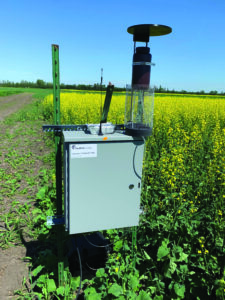Sclerotinia spore sensor gets a patent
KEY RESULT:
InnoTech researchers have patented an automatic field unit that can count Sclerotinia sclerotiorum spores over a set period of time. They deployed six units in 2022 and are troubleshooting mechanical issues, mostly to do with the system’s internal clock and power supply.
PROJECT TITLE, PRINCIPAL INVESTIGATOR:
“Development of a biosensor for sclerotinia stem rot disease forecasting in canola,” Xiujie Li, InnoTech Alberta
FUNDING:
AgriScience Program (Canola Cluster) under the Canadian Agricultural Partnership
PUBLISHED ARTICLES:
Pedro A. Duarte, Lukas Menze, Gaser N. Abdelrasoul, Shari Yosinski, Zak Kobos, Riley Stuermer, Mark Reed, Jian Yang, Xiujie S. Li and Jie Chen. 2020. Single Ascospore Detection for the Forecasting of Sclerotinia Stem Rot of Canola. Lab on a Chip 20: 3644-3652
Lian C. T. Shoute, A. Anwar, S. MacKay, G. N. Abdelrasoul, D. Lin, Z. Yan, A. H. Nguyen, M. T. McDermott, M. A Shah, J. Yang, J. Chen, and X. S. Li*. 2018 Immuno-impedimetric biosensor for onsite monitoring of ascospores and forecasting of Sclerotinia stem rot of canola. Scientific Reports 8 (12396).
In this project to develop a sclerotinia spore detection tool, researchers redesigned their spore collection unit then deployed six of them to Alberta fields for evaluation.
Each unit gathers airborne Sclerotinia sclerotiorum spores in a liquid trap. In the liquid are microbeads coated with an antibody that specifically binds to S. sclerotiorum spores. This separates the target spores from other spores that land on the sensor. Once per hour, the system turns on to agitate the sample tray so the antibodies can bind with the spores. A second pump moves the mixed sample into a holding chamber for analysis.

The system performs an analysis sequence once per day. Units use both a nano-scale impedance sensor and vision-based optics to detect spores. The spore-carrying liquid runs through the flow cell, a very narrow chamber where impedance sensors use electrical charges to measure how each spore impedes the charge. Sclerotinia sclerotiorum spores have their own impedance fingerprint. Vision-based detection uses a camera and magnification lens clamped to the flow cell assembly. It can see the spore-coated microbeads. A computer and coded software analyze the images. The same computer runs all functions of the automated unit. Units include a modem to send daily reports and a 12-volt battery.
Results

In the summer of 2022, researchers deployed six biosensor units to canola fields in Leduc, Devon, Viking, Lavoy and Vegreville. (Vegreville got two.)
Units passed the initial tests for assembly and wireless communication. Each got a test run before deployment.
One unit collected data for 25 days of the 30 days deployed and other units only collected data periodically or stopped collecting after a short duration after installation.
A field issue occurred with the real time clock board (RTC). Troubleshooting indicated that the RTC would randomly change its internal clock and randomly reschedule the start times. On some of the deployed systems, the battery was found to prematurely run low and the field analysis would stop.
The battery was changed to a power supply, which permitted long term tests without the need to maintain a battery on a charger. The RTC issue is presently under review and evaluation with the ongoing testing. Transitioning to full power down and RTC wakeup is required prior to changing back to battery.
Researchers obtained a U.S. patent for their biosensors. They also confirmed that their anti-S. sclertotiorum antibodies are very specific with high affinity to S. sclerotiorum. They have no affinity to Botrytis cinerea, Leptosphaeria maculans, and Fusarium graminearum – the other common spores in the air around farm fields.





